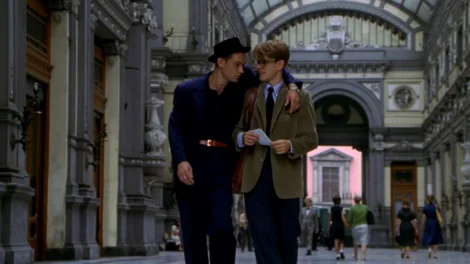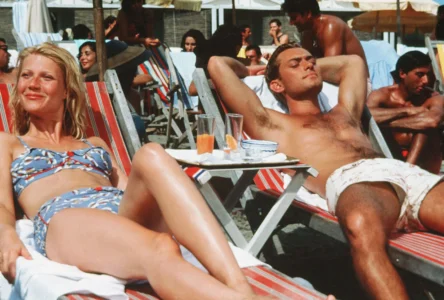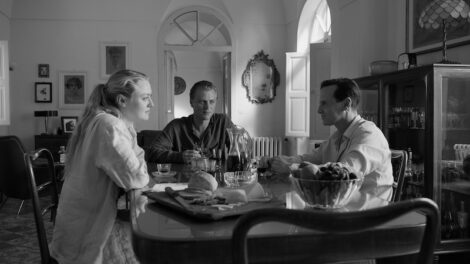The Talented Mr. Ripley
Front Row at the Movies by Shirrel Rhoades
[mr_rating_result]Patricia Highsmith (1921–1995) was an American novelist known for her psychological crime thrillers.
Alfred Hitchcock liked her sense of macabre. He turned to Highsmith for his film “Strangers on a Train” (1951). Hitch even used one of her stories on TV’s “The Alfred Hitchcock Hour.” And the maestro collected four of her short stories in his various mystery anthologies.
 Highsmith is noted for her stinging satirical stories tinged with black humor. In particular, she is recognized for her Ripliad series of books about the character of Thomas Ripley, a charming con man and serial killer.
Highsmith is noted for her stinging satirical stories tinged with black humor. In particular, she is recognized for her Ripliad series of books about the character of Thomas Ripley, a charming con man and serial killer.
There were five Ripley books in all – “The Talented Mr. Ripley,” “Ripley Under Ground,” “Ripley’s Game,” “The Boy Who Followed Ripley,” and “Ripley Under Water” – published between 1955 and 1991. In each, he comes perilously close to being caught, but manages to escape punishment.
The Guardian noted, “It is near impossible, I would say, not to root for Tom Ripley. Not to like him. Not, on some level, to want him to win. Patricia Highsmith does a fine job of ensuring he wheedles his way into our sympathies.”
“Suave, agreeable and utterly amoral,” Tom Ripley has no qualms in taking people’s money (he owns part of an art gallery that sells counterfeit paintings) or killing a friend in order to avoid exposure. It’s all a chess game to him.
Today, the Book Lover’s Film Series at the Tropic Cinema is showing “The Talented Mr. Ripley” (1999), starring Matt Damon as Highsmith’s eponymous bad boy. Directed by Anthony Minghella (Oscar-winner for “The English Patient”), this suspenseful thriller was lushly filmed in Italy, as inviting as a deluxe picture postcard. The dazzling scenery and warm vibrant colors notwithstanding, I’d still classify this film as neo-noir. The attitude is dark and foreboding, despite the travelogue-like cinematography by John Seale.
The cast is great. In addition to Damon, you’ll be impressed by Jude Law, Gwyneth Paltrow, Cate Blanchett, Philip Seymour Hoffman, and Philip Baker Hall.
The plot: Believing Tom Ripley attended Princeton with his son Dickie, a shipping magnate hires Ripley to travel to Italy and persuade the wastrel to return to the United States. But thing go awry when Ripley begins to envy Dickie’s extravagant lifestyle and becomes obsessed with Dickie himself, eventually assuming his identity.
 As The New Yorker puts it, “Deception, sexual intrigue, and murder ensue.”
As The New Yorker puts it, “Deception, sexual intrigue, and murder ensue.”
There have been several other screen versions.
You may not as quickly recognize René Clément’s “Purple Noon” (1960), the French adaptation in which Alain Delon gives a performance that Highsmith herself praised as “excellent.”
And “Ripley’s Game” was filmed as “An American Friend” (1977), starring Dennis Hopper. Highsmith initially disliked Hopper’s Ripley, but changed her mind after seeing the film a second time.
Other adaptations include “The Talented Mr. Ripley” (2002), starring John Malkovich; and “Ripley Under Ground” (2005), starring Barry Pepper. Also, there have been numerous television versions.
What makes this timely? Turns out, there’s a new eight-episode limited series on Netflix called “Ripley.” A “re-imagining” of Patricia Highsmith’s 1955 crime novel, it stars Andrew Scott (“Fleabag”) as Tom Ripley, Johnny Flynn (“Stardust”) as his friend Dickie Greenleaf, and Dakota Fanning (“Oceans 8”) as Marge Sherwood. John Malkovich makes a guest appearance.
The series was created, written and directed by Oscar-winner Steven Zaillian (screenwriter of “Schindler’s list,” “Gangs of New York,” “The Irishman,” etc.).
A moody period piece, this look inside Ripley’s twisted mind is made even more menacing when seen in black-and-white. The cinematography here is by Oscar-winner Robert Elswit (“There Will Be Blood”).
Why black-and-white for a tale set in sunny Italy? “The story itself is a rather dark and sinister,” says Zaillian. “I didn’t want blue skies; I wanted cloudy skies, rain and rain-glistening streets. I had that look in mind from the beginning.”
A surprise hit, “Ripley” made it into Netflix’s Top 10 list the week of its premiere on April 4.
“There is a notion of class and morality, and also about sexuality as well. I think there’s a kind of murkiness to Tom’s sexuality, whether it’s envy or lust or love or obsession,” says star Andrew Scott.
 While Patricia Highsmith never explicitly portrayed Ripley as gay or bisexual, we’re often left with that impression. He jokes that he wants to give up both men and women because he cannot decide which he likes more.
While Patricia Highsmith never explicitly portrayed Ripley as gay or bisexual, we’re often left with that impression. He jokes that he wants to give up both men and women because he cannot decide which he likes more.
Highsmith herself was ambivalent about Ripley’s sexuality. “I don’t think Ripley is gay,” she said in a 1988 interview. “He appreciates good looks in other men, that’s true. But he’s married in later books.”
Andrew Scott says, “I asked all those questions about the character and how much we should label him in relation to where he might come from, or what exact age he might be, or what his exact sexuality might be, or what his exact pathology might be. But all those questions, to me, sometimes were more interesting than the answers. I think what’s fascinating and enduring about this character is that he’s sort of like water. There’s a fluidity to him that we can’t quite put our finger on. For that reason, he holds a sort of power over us.”
The novelist’s dark world view possibly limited her book sales. But she didn’t seem to mind. “I find the public passion for justice quite boring and artificial,” she observed, “for neither life nor nature cares if justice is ever done.”
Email Shirrel: srhoades@aol.com


Ratings & Comments
[mr_rating_form]